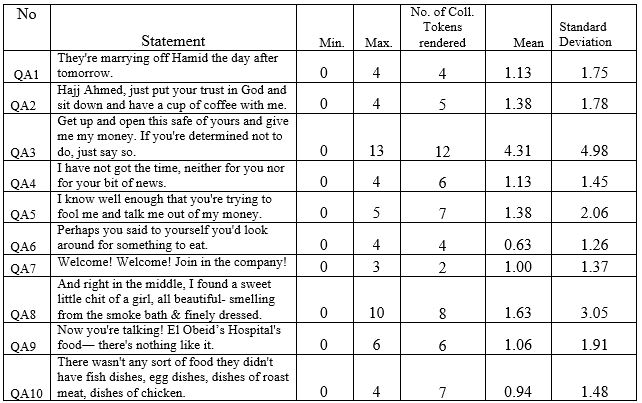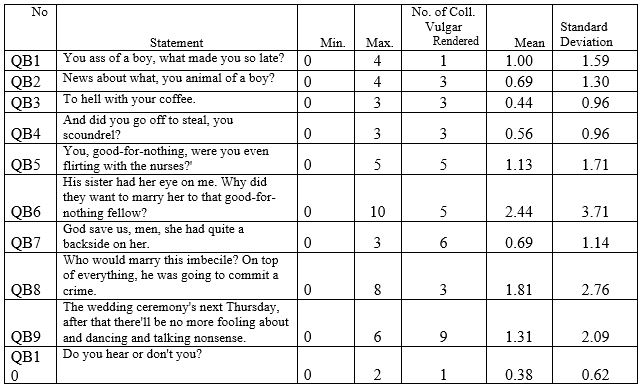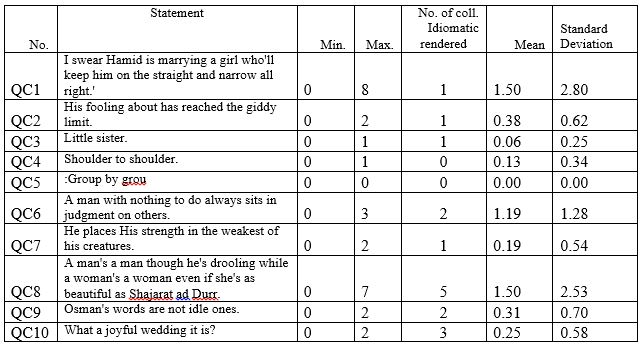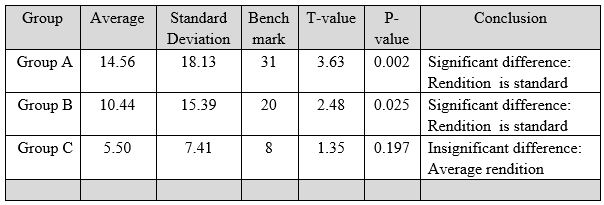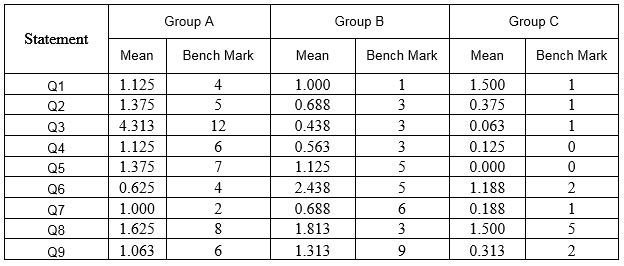
October 2016 Issue
Read, Comment and Enjoy!
Join Translation Journal
Click on the Subscribe button below to receive regular updates.
Using Back Translation to Test Rendition of Colloquial Expressions
- Details
- Written by Dr. Abdelwahid Ayoub Mohamed Hamadelneel

Abstract (200 words)
- title page;; keywords; main text;; references; appendices (as appropriate); table(s) with caption(s) (on individual pages); figure caption(s) (as a list).
- Abstracts of are required for all manuscripts submitted.
- Each manuscript should have 5 to 6 keywords.
- Search engine optimization (SEO) is a means of making your article more visible to anyone who might be looking for it. Please consult our guidance here.
- Section headings should be concise.
- All authors of a manuscript should include their full names, affiliations, postal addresses, telephone numbers and email addresses on the cover page of the manuscript. One author should be identified as the corresponding author. Please give the affiliation where the research was conducted. If any of the named co-authors moves affiliation during the peer review process, the new affiliation can be given as a footnote. Please note that no changes to affiliation can be made after the manuscript is accepted. Please note that the email address of the corresponding author will normally be displayed in the article PDF (depending on the journal style) and the online article.
- All persons who have a reasonable claim to authorship must be named in the manuscript as co-authors; the corresponding author must be authorized by all co-authors to act as an agent on their behalf in all matters pertaining to publication of the manuscript, and the order of names should be agreed by all authors.
- Please supply a short biographical note for each author.
- Please supply all details required by any funding and grant-awarding bodies as an Acknowledgement on the title page of the manuscript, in a separate paragraph, as follows:
- For single agency grants: "This work was supported by the [Funding Agency] under Grant [number xxxx]."
- For multiple agency grants: "This work was supported by the [Funding Agency 1] under Grant [number xxxx]; [Funding Agency 2] under Grant [number xxxx]; and [Funding Agency 3] under Grant [number xxxx]."
- Authors must also incorporate a Disclosure Statement which will acknowledge any financial interest or benefit they have arising from the direct applications of their research.
- For all manuscripts non-discriminatory language is mandatory. Sexist or racist terms must not be used.
- Authors must adhere to SI units. Units are not italicised.
- When using a word which is or is asserted to be a proprietary term or trade mark, authors must use the symbol ® or TM.
Using Back Translation to Test Rendition of Colloquial Expressions
The Case of Johnson Davies’ Translations of Tayeb Salih’s Colloquial Expressions
1.0 Overview:
Tayeb Salih is the greatest Sudanese storyteller whose writings have been translated to readers all over the globe. This study aims at examining the pioneering translation into English performed by Denys Johnson Davies' with emphasis on the rendition of conversational utterances as mainly displayed in Salih’s novel: The Wedding of Zein, known for involving challenges and complications due to inclusion and/or treatment of colloquial and cultural aspects and contexts.
Salih wrote his stories in an Arabic style in which standard and colloquial language have been blended to form one that would appeal to the senses of different levels of readers described by Pergnier (cited by Trablesi: 2000: 470, researcher’s translation) as:"We dispose of many languages: a correct and official one, another familiar one, a third vulgar, a fourth argotic, and we move with grand ease from one style into the other, at times in a nice medium of a phrase". The present study selected colloquial translated statements and divided them into 3 groups: merely colloquial, vulgar and idiomatic. The products were exposed to back translation as a means to check- through the reproduced ratio and form of the original- Johnson Davies’ degree of representation of the original.
1.1 Back-Translation
Back-translation- obtained by retranslating a translated input into its original language- is proposed for this study as a viable method capable of: a) allowing a deeper insight into the rendition of materials at hand, b) facilitating a clear identification of and reflection from the differences between SL texts and TL products, and c) suggesting broader translational options and recommendations.
By weighing the sum of original information returned back conveniently, the method attempts to judge the current respondents’- as well as the ultimate recipients’- perception of the translated products. A package of selected relevant materials (translated statements .i.e., 10 each) representing the three linguistic levels is evaluated based on this question: “How much of the component of the SL has been rendered in the TL?” The results will be calculated for every group of sentences towards comparative insights. A larger percentage means, logically, more conformity of back-translated texts to Salih's original expressions and therefore favorable evaluation of Davies’ renditions.
1.2 Processing the method
To secure a successful and reliable employment of the method, a number of procedures have been taken into account:
- As a precautionary measure, the researcher had to ensure that the selected back-translators are totally foreigners to the experiment. Neither were they aware of the subject of the thesis, nor the origin of the material assigned to them. The researcher paid the price of that as he was forced to avoid- in assigning the back translation work- charging any of the many fellow translators and close colleagues whom he knew to be familiar with the subject of thesis.
- To achieve the above, the material has carefully been scrutinized to free it from any hints referring to or suggesting links to the original texts: names, places or terms either by erasing or altering such referents.
- Besides translators and English language teachers, the researcher also confined the assignment, in drawing up the samples, to a number of Sudanese nationals with an almost native knowledge of the English language for reasons related to prolonged stay and/or familiarity with English-speaking countries.
1.3 Bases for Calculation and Evaluation of Produced Back-Translations
For calculation and evaluation of the reproduced works, the researcher applied the following criteria:
- Any term that can equally be used in oral and written situations shall be considered as standard, (وقت، أقعد، فنجان : cup, sit down, time).
- Terms referring to Sudanese- based cultural concepts such as فركة، قرمصيص are considered colloquial and if not rendered, this will deduct from back-translation.
- Any letter transforming a standard word into colloquial according to local use turns the term into colloquial, such as the (بـِ) in the example: بتتغزل مع الممرضات: flirting with nurses.
- A standard word- when used colloquially- will not be so considered, so long as its spelling has not been changed عندها مؤخرة خطيرة what a backside she has.
- Any word manipulated as per colloquial style is considered colloquial: شِي بدلاً من شئ: one thing for another thing.
- Adding a letter to a standard term according to colloquial use turns it into colloquial such as the (ة) in the example: الحلوة والمرة: both sweet and bitter.
- Adding الـ to ما =الما is a colloquial practice of classical reference and is counted as such: the not.
- Any term or expression used colloquially- either metaphorically or in terms of meaning- is considered as such (i.e., ما وقع البحر): not idle.
1.4 Descriptive Analysis of the Translators' Samples
The sample of the translators is composed of 30 respondents; the analysis of their collected data is achieved using various components and derivatives of the Statistical Package for Social Sciences.
Male respondents consitituted an overwhelming majority, .i.,e., 26. However, this would in no way influenced the responces since the sample was selected on purely competence basis, irrespective of sex type. Out of the 30 respondents, 17 were academitians and the remaining 13 were translators. This difference is too slim to mark a significant contribution to the display of any biased response to the presented material. Empirically, the responses of the two groups (translators versus academicians) were statistically compared. The analysis showed no significant difference in average rendering according to the profession of the back translator, as they both shared similar tendency towards standard translation for the 1st and 2nd groups of sentences, and achieved an average result for 3rd Group (Table 1). This finding is, in fact, only limited to this assignment’s utterances which are characterized by ordinary and non-specialized composition and cannot be extended to form any basis for the claim that any translational task can equally be rendered by both professional translators and academicians.
Table 1
Comparison of Level of Translation between Academicians and professional Translators
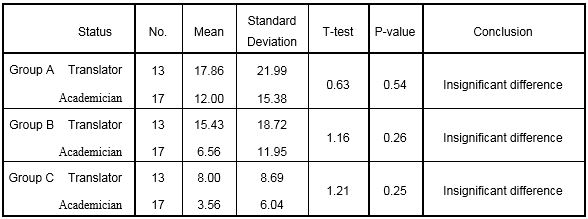
1.5 Descriptive Analysis for the Translation of Data
The following tables exhibit the three groups of back-translated colloquial statements statistically analyzed to determine the minimum and maximum number of tokens rendered either to standard or colloquial origin. The mean factor is then calculated and the standard deviation is used to calculate the outcome.
Table 2
Summary Statistics for Group A (Colloquial Statements)
Table 3
Summary Statistics for Group B (Colloquial Vulgar Statements)
Table 4
Summary Statistics for Group C (Colloquial idiomatic expressions)
With an overall number of 61 colloquial tokens reproduced by the respondents for Group 1; making an average below the bench mark (approximately 31) the result is self- revealing and would lead to the conclusion that the respondents opted for a rather standard rendition of the presented materials. The results of both Group 2 (39 total number of colloquial tokens rendered by the respondents and a bench mark of 20) further consolidated this outcome, while Group 3 (30 rendered tokens and an insignificant bench mark of 8) would imply a tendency neither to standard nor to colloquial option.One reason to justify the latter outcome is the strategy available to back translators which enables them to reproduce the colloquially idiomatic statements with equivalent straight forward correspondents in the original language using relevant strategy.
Therefore, all the results fell below the average required to falsify the laid forward hypothesis: showing a tendency towards colloquial rendition of the material submitted for translation.
The researcher sought to understand whether or not the level of translation differed according to the type of materials translated. To test this hypothesis, one-way analysis of variance (ANOVA) technique has been used. The translation for the three groups (mere colloquial, coll. vulgar, and coll. idiomatic) has been compared. If the difference among these groups was found to be significant, a conclusion can be drawn that the level of rendition differs according to the type of statement translated. The results of the test are given in Table (5) below:
Table 5
The Average Translation According to Type of Statements (n=30)
Table 5 shows that there is no significant difference in average rendition according to the type of translated statement whether it is colloquial, vulgar, or idiomatic (P-value > 0.05). This would mean that irrespective of the type of statement translated, the back- translators opted for a standard option in reproducing it.
To test the outcome of the back translation assignment- divided into the three distinguished material groups- the one-sample t-test has been used, whereby the average of rendition stated by respondents in each group has been compared to the total number of colloquial tokens in each group, for example, group A consisted of 61 colloquial tokens, rendering 31 out of this would mean that the respondents have just scored the average. This average has been taken as a bench mark to be compared with the actual translation undertaken by the respondents. If the average of tokens rendered is above this bench mark (namely 31 or more), we conclude that the level of rendition tends towards colloquial, and if it is below that bench mark, it would mean that back-translational reproduction favors the standard option. The results of the test are given in the Table (6) below:
Table 6
The Average Translation for the Three Groups of Statements
What can be noticed from Table (6) is that:
- The average rendering for Group A is 14.56 which is below the bench mark of 31 for colloquial tokens, indicating thus, a significant difference (p-value < 0.005) between the average translation and the bench mark, which means that rendition tends towards standard. Of the average number of colloquial tokens in Group A, respondents succeeded in rendering only half of the quantity, .i.e., (14.56).
- For Group B, comparing the average rendering of (10.44) to the bench mark of (20) indicates a significant difference in favor of a standard percentage of rendition s; (p-value < 0.05).
- For group C, the test indicates that there is no significant difference between the average translation and the bench mark (p-value > 0.05). This shows that the translation is just average.
Table 7
Average Rendition and the Bench Mark for the Three Groups' statements
It is obvious from Table 7 that the mean rendering is very low for group A and group B as compared to the bench marks, indicating an overall type of standard translation. For group C, with the exception of statement number 8, there is similarity between the mean translation and the bench mark, indicating that the translation tends to be average.
1.6 Conclusion and recommendations
This study has attempted to examine the translation into English of colloquial expressions in Tayeb Salih stories using statistical tests for responses from back translators to weigh their impact on recipients. The empirical study revealed that the colloquial airs enshrined-in Salih's writings did not come across well in Johnson's translation. A rather fully representative- both linguistically and stylistically- fresher translations may be required to fill this.
It is hoped that this study could pave the way for investigating challenges resulting from the translation of other linguistic and stylistic levels and aspects in Tayeb Salih writings as well as carrying out further comparative investigation of such translations into other languages.
Acknowledgements
References
Davies, J. (2006). Memories in Translation: A Life Between the Lines of Arabic Literature. American
University in Cairo Press. Cairo.
Salih, T. (1999). The Wedding of Zein & Other Stories (D. J. Davies, Translation). African Writers Series:
Heinemann. (Original work published 1966).
Trabelsi, C. (2000). La Traduction des Niveaux de Langue et des Régionalismes de l'Arabe en Français dans
le Roman de Taïeb Salah, Saison de la Migration vers le Nord. Meta: Translators' Journal. 45(3): pp.
465-474
Appendix One
Back Translation Assignment
Dear colleague, translator,
As part of empirical research for my PhD thesis, I am investigating the reproduction by translators of the following sentences, clauses and phrases classified into three groups of linguistic and stylistic levels. Please back-translate the same into Arabic. This will allow for analytical and comparative review with the originals in Arabic.
Group A ِ
- They're marrying off Hamid the day after tomorrow.
- Hajj Ahmed, just put your trust in God and sit down and have a cup of coffee with me.
- Get up and open this safe of yours and give me my money. If you're determined not to do, just say so.
- I have not got the time, neither for you nor for your bit of news.
- I know well enough that you're trying to fool me and talk me out of my money.
- Perhaps you said to yourself you'd look around for something to eat.
- Welcome! Welcome! Join in the company!
- And right in the middle, I found a sweet little chit of a girl, all beautiful- smelling from the smoke bath & finely dressed.
- Now you're talking! El Obeid’s Hospital's food― there's nothing like it.
- There wasn't any sort of food they didn't have fish dishes, egg dishes, dishes of roast meat, dishes of chicken.
Group B
- You ass of a boy, what made you so late?
- News about what, you animal of a boy?
- To hell with your coffee.
- And did you go off to steal, you scoundrel?
- You, good-for-nothing, were you even flirting with the nurses?'
- His sister had her eye on me. Why did they want to marry her to that good-for- nothing fellow?
- God save us, men, she had quite a backside on her.
- Who would marry this imbecile? On top of everything, he was going to commit a crime.
- The wedding ceremony's next Thursday, after that there'll be no more fooling about and dancing and talking nonsense.
- Do you hear or don't you?
Group C
- I swear Hamid is marrying a girl who'll keep him on the straight and narrow all right.'
- His fooling about has reached the giddy limit.
- Little sister.
- Shoulder to shoulder.
- Group by grou:
- A man with nothing to do always sits in judgment on others.
- He places His strength in the weakest of his creatures.
- A man's a man though he's drooling while a woman's a woman even if she's as beautiful as Shajarat ad Durr.
- Osman's words are not idle ones.
- What a joyful wedding it is?
